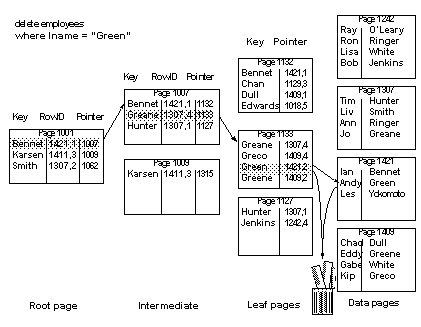When you delete a row from a table, the query can use a nonclustered index on the columns in the where clause to locate the data row to delete, as shown in Figure 12-10.
The row in the leaf level of the nonclustered index that points to the data row is also removed. If there are other nonclustered indexes on the table, the rows on the leaf level of those indexes are also deleted.
Figure 12-10: Deleting a row from a table with a nonclustered index

If the delete operation removes the last row on the data page, the page is deallocated and the adjacent page pointers are adjusted in allpages-locked tables. Any references to the page are also deleted in higher levels of the index.
If the delete operation leaves only a single row on an index intermediate page, index pages may be merged, as with clustered indexes.
See “Index page merges”.
There is no automatic page merging on data pages, so if your applications make many random deletes, you may end up with data pages that have only a single row, or a few rows, on a page.